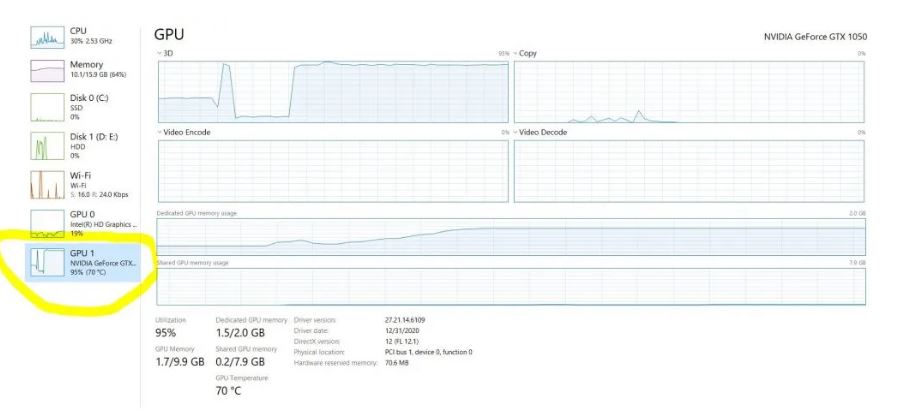Quick Navigation
During an idle state, the normal GPU temp while gaming is completely different. GPU temperatures generally range between 38°C and 55°C without any workload.
A GPU’s temperature increases as you put a graphical workload on it. Also, GPU temperatures change depending on the workload placed on them. GPU temperatures can differ in gaming compared to photo or video rendering.
Optimal GPU temperatures range from 60°C to 85°C when gaming. The graphics card will throttle down its performance if the limit is exceeded in order to avoid any permanent damage. Temperatures between 85°C and 185°F are the safest for GPUs.
Average Temperatures on a Graphics Card
| While Gaming | 60°C to 85°C |
| GPU Rendering (Video Editing, 3D Rendering, etc) | 65°C to 80°C |
| Normal Workload | 55° to 75° C |
| Idle | 38°C to 55°C |

Temp of GPU While Playing SnowRunner Game

Gpu Ceiling Temperature – Maximum Safe Range
The temperature of a video card should stay between 75°C to 85°C, as we mentioned earlier. Overclocking graphics cards can even push them to their limits. It is possible to witness temperatures higher than 85°C and up to 110°C (230°F) when overclocking a graphics card.
Third-party graphics card manufacturers say it’s normal for AMD’s RX 6000 Series graphics cards to get this hot. However, Nvidia RTX 30-Series chips can operate at temperatures as high as 93°C without issue.
You don’t have to worry about temperatures hitting 95°C as long as you have a reliable cooling solution installed on your graphics card.
What Causes Gpus To Get Hot?
Your graphics card could be hitting higher temperatures for a variety of reasons. However, you must keep in mind that the temperature of your card will increase if you place some sort of workload on it.
How high can the temperature rise? Depending on how your graphics card is handled, this may or may not be possible.
Compared to liquid-cooled graphics cards, air-cooled cards get much hotter. Water-cooled GPUs might have a different normal temperature range than air-cooled GPUs during gaming.
Your GPU may be getting hot for a variety of reasons:
Heat In The Room
Your GPU’s thermal performance would also be affected if your room temperature is higher. It is known that heat travels from a hot body toward a cold body. It is therefore necessary to transfer the heat to an environment that has a lower temperature in order to effectively dispose of it.
As a result of every 1°C increase in room temperature, your graphics card’s temperature rises by 1°C. It is evident from this that your graphics card is directly related to the temperature rising inside your room.
Hence, if you live in a hot climate, make sure you have plenty of ventilation throughout your room. A fresh supply of air should be available near your PC.
Aspects Of Pc Cases And Form Factors
Heat buildup is more likely if all of your hardware is crammed into a small PC case. Your PC case will therefore take longer to cool as a result of the heat produced by other components. A graphics card’s temperature will increase if it has no way to escape the increasing heat.
Our experience has shown that small-form-factor PC graphics cards typically run hotter than normal. In most cases, this is caused by hardware that is cramped within a tight space with limited room for hot air to escape.
PC cases are also important when it comes to cooling graphics cards. You can also help your graphics card cool down if your PC case has plenty of fans. If your PC case does not have fans at the front and back, you will not be able to cross-ventilate.
A Dusty Graphics Card
The graphics card inside your PC case is likely to collect a lot of dust. A graphics card that hasn’t been cleaned in a long time will collect dust. As we know, a graphics card’s overall temperature rises as it absorbs more heat.
If you want to remove the dust from your graphics card, you should use a compressed air can.
Graphics Card Temperature Check
Here are some methods we use to monitor GPU temperatures:
Task Manager In Windows
To monitor the performance of your hardware, Windows has a built-in Task Manager. To access your Task Manager, press CTRL+ALT+DEL. On the left side, click the “Performance” tab, and you’ll see the list of hardware. You’ll see a graph of temperature and performance metrics under “Graphics Card” at the bottom.

The Use Of Third-Party Software
You can also monitor your graphics card’s temperature using third-party applications. In addition to GPU-Z, HWInfo, Rainmeter, and IDA64 Extreme, there are numerous other reliable programs. GPU-Z is a free and easy-to-use software we always use to monitor graphics card temperatures.
Conclusion
Last but not least, you now understand that graphics cards’ temperatures are variable and depend on the workload they undergo. GPU temperatures range from 60°C to 85°C when playing games. You should take the necessary steps if your GPU’s temperature rises above this range. We will get back to you with the right solution if you witness unusual temperatures on your graphics card.


1 thought on “What’s A Normal Gpu Temp While Gaming”